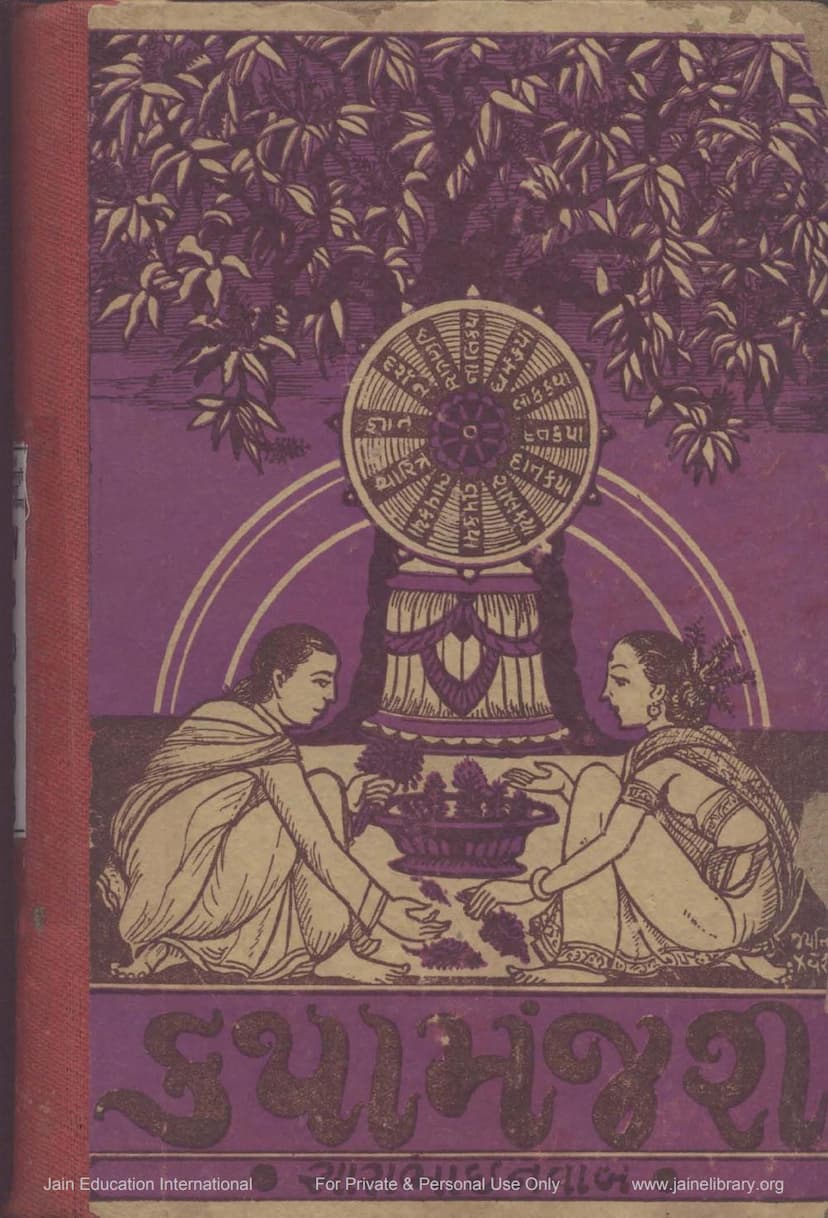Katha Manjari Part 03
Added to library: September 2, 2025

Summary
Here's a comprehensive summary of the Jain text "Katha Manjari Part 03" by Sarabhai Manilal Nawab:
Overall Purpose and Content:
"Katha Manjari Part 03" is the third installment in a series that aims to present Jain religious stories and teachings in an accessible Gujarati format. This particular volume focuses on the life and exemplary deeds of Shri Shripal Maharaj, a significant figure in Jain lore, particularly renowned for his devotion to the Shri Siddha Chakra (Navpadji). The book serves as a "Tapkatha" (story of penance and its results), highlighting the power of devotion and the law of karma.
Key Highlights and Themes:
-
The Legend of Shri Shripal: The core of the book is the detailed narrative of Shri Shripal's life, encompassing his miraculous birth, his trials and tribulations, his devotion to the Navpadji, and his eventual attainment of great fortune and spiritual merit.
-
The Significance of Navpadji (Shri Siddha Chakra): A central theme throughout the book is the profound importance of worshipping and meditating upon the nine sacred syllables or entities of the Siddha Chakra (Arhant, Siddha, Acharya, Upadhyay, Sadhu, Darshan, Gyan, Charitra, Tap). The narrative demonstrates how Shripal's unwavering devotion to the Navpadji enabled him to overcome immense difficulties, including physical afflictions and social ostracism.
-
The Law of Karma: The story vividly illustrates the Jain principles of karma. Shripal's suffering, such as contracting leprosy, is depicted as a consequence of past actions, while his eventual salvation and prosperity are shown as the direct result of his virtuous deeds and devotion. The book emphasizes that one reaps what one sows.
-
The Power of Penance (Tapa): The narrative showcases how Shripal's intense penances, particularly his adherence to the Navpadji ritual, brought about miraculous transformations and blessings.
-
The Role of Virtue and Righteousness: The story contrasts the virtuous characters like Shripal and his devoted wife Mayanasundari with negative characters like Shripal's cousin Ajitsen and the merchant Dhaval. It highlights how righteousness, faith, and good conduct ultimately lead to success and well-being, while greed, malice, and deceit result in downfall.
-
The Power of Faith and Devotion: The unwavering faith of Shripal and Mayanasundari in Jain principles and the Navpadji is a recurring motif. This faith allows them to endure hardships with equanimity and ultimately achieve their goals.
-
Detailed Narratives and Illustrations: The book is rich in descriptive narratives and includes numerous illustrations (as indicated by the "Chitranukramanika"). These illustrations likely depict key events, characters (like the Yakshas and Yakshinis), and rituals, making the story more engaging for the reader.
-
Historical and Cultural Context: The book provides insights into historical aspects, such as maritime trade routes in 15th-century Gujarat (mentioning ports like Bharuch and Thane) and describes different types of ships. It also includes the "Shripal Ras," a significant Jain poetic work.
-
Comparative Study of Texts: The editor, Sarabhai Manilal Nawab, explains that this Gujarati translation is based on the original "Shri Shripal Kahā" by Acharya Ratnashekhar Surishwarji and also incorporates relevant portions from "Shripal Ras" by Mahamahopadhyay Vinayvijayji. Differences between the two original works are footnoted for clarity.
-
Educational and Inspirational Value: The preface emphasizes the book's purpose to educate and inspire readers by presenting the life of Shripal as an example of how devotion to the Navpadji and adherence to Dharma can lead to liberation from suffering and the attainment of happiness.
Key Characters and Events:
- Shripal: The protagonist, who begins his life afflicted with leprosy but achieves spiritual and material prosperity through devotion.
- Mayanasundari: Shripal's virtuous wife, whose faith and adherence to Jain principles play a crucial role in Shripal's transformation and welfare.
- King Prajapal (Shripal's father-in-law): Initially disapproves of Shripal due to his condition but later recognizes his true worth.
- King Ajitsen: Shripal's envious cousin who attempts to usurp his kingdom.
- Merchant Dhaval: A greedy merchant who plots against Shripal, leading to his own destruction.
- King Mahakal: The ruler of a port city who is initially hostile but later respects Shripal.
- King Vajrasen: The father of Shringar Sundari, who holds a musical contest.
- King Dhanapala: The father of Tilokasundari.
- The Seven Lepers: Initially Shripal's companions, who are cured by the grace of the Navpadji.
- The Worship of Navpadji: The ritualistic and devotional practice that forms the backbone of Shripal's journey.
- The Royal Succession: The story involves political intrigue, usurpation, and eventual regaining of the kingdom.
- The Miraculous Cures: Shripal's leprosy and the king's daughter's snakebite are miraculously cured through devotion.
- The Musical Contest: Shripal participates in contests of skill, demonstrating his mastery and earning the hand of princesses.
Structure of the Book:
The book is divided into chapters (numbered as chapters 135 through 159 in the provided text) that cover various episodes of Shripal's life, including:
- Dialogues and tests.
- The worship of the Siddha Chakra.
- The intricacies of karma.
- The triumph of Shripal and his devotion.
- His voyages and encounters.
- His eventual conquest and coronation.
- His past lives and the karmic roots of his experiences.
In essence, "Katha Manjari Part 03" is a spiritually uplifting narrative that meticulously details the life of Shri Shripal Maharaj, emphasizing the transformative power of devotion to the Navpadji, the inescapable nature of karma, and the ultimate triumph of virtue.